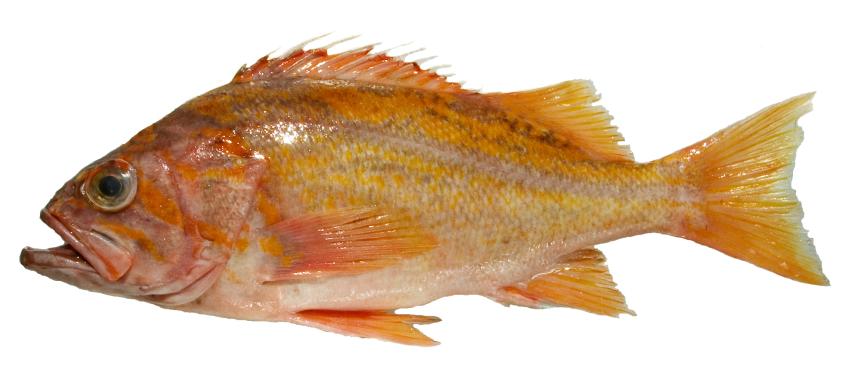Description and Range
Physical description
Canary Rockfish have an elongate, moderately deep and compressed body form. Adults are yellow-orange in body color on a white to gray background, with gray mottling on the back and a lateral line that is highlighted above and below in gray. Canary Rockfish have three bright orange diagonal stripes across their head, including one on either side of their eye. Their fins are yellow-orange, and the anal fin is pointed with a rear edge that slants forwards towards the head of the fish. In smaller individuals (less than 14 in), there is often a black spot near the back of the first dorsal fin.
Canary Rockfish resemble Vermilion Rockfish, but captured individuals can be distinguished based on the presence or absence of scales on the underside of the lower jaw. Canary Rockfish lack under-jaw scales, and the lower jaw feels smooth when rubbed from back to front. Vermilion Rockfish have scales present underneath their lower jaw, which results in a rough texture when rubbed from back to front. While Canary and Vermilion may be easily confused under water, the Vermilion has black fin edges and a rounded, vertical rear anal fin edge, whereas Canary fins are yellow-orange with a leading white edge and are angular.
Canary Rockfish can grow up to 76 cm (30 in) in length and 6.7 kg (14.7 lb) in weight. Maximum age is at least 84 years old.
Geographic range
Canary Rockfish are found around the Pribilof Islands in the eastern Bering Sea, and from the Gulf of Alaska south of Shelikof Strait, to Punta Colnett, northern Baja California. Young fish tend to be found in shallower water depths than adults. Adults are most commonly found at water depths from 80-200 m (262-656 ft), but have been found at depths of up to 838 m (2,749 ft).
State record
- Weight
- 10.57 lbs
- Angler
- Ben Phillips
- Location
- Neah Bay, Clallam County
- Date Caught
- August 30, 1986
